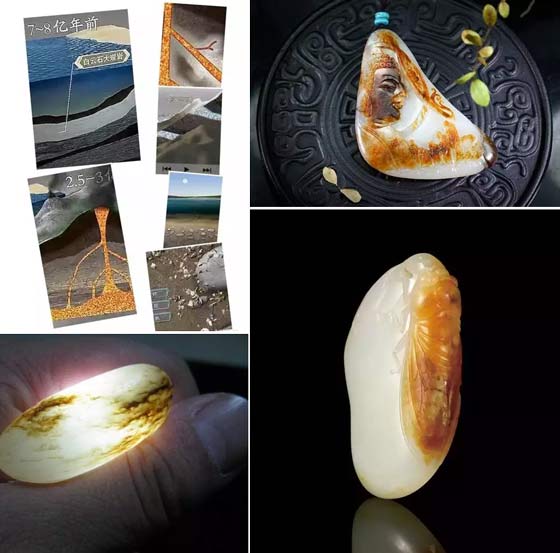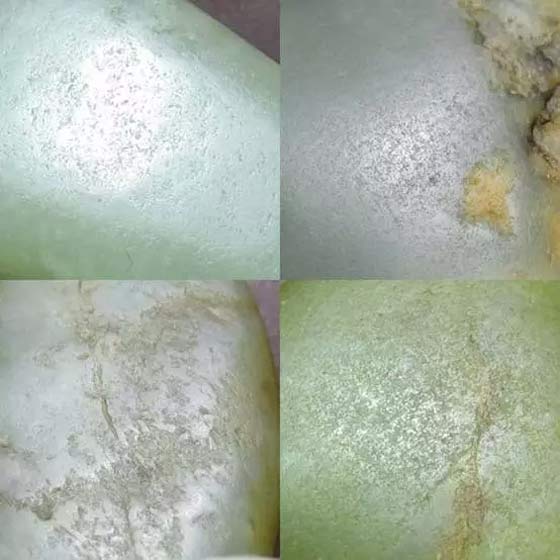Billion years of Hetian jade seeds, identification of flaws
Hetian jade's life history is longer than human origin.
About 700-800 million years ago, the southern part of Xinjiang, China, is still vast. On the seabed, a large number of dolomite marble deposits are deposited, which is the original embryo of Hetian jade.
About 2.5 to 300 million years ago, under this vast ocean, a large amount of hot magma emerged, quietly infiltrating into the dolomite marble. In the harsh conditions of temperatures up to 300-400 ° C, the rock structure has undergone a wonderful change, which forms Hetian jade.
About 10 million years ago, the Himalayan orogeny broke out and the Bohai Sea transformed into a high mountain. As the earth's crust continues to rise, Hetian jade has a subtle opportunity to meet humanity.
Billion years of Hetian jade, descending on earth
The Hetian jade deposit rises with the uplift of the Kunlun Mountains. The original jade stone ore on the mountain gradually became a fragment after long-term water erosion and weathering, and was transported to the valley river under the action of the wind and sand glaciers. The raging floods, with jade rushing in the river, the edges and corners were ground into an ellipse. When the riverbed widened, the entrained jade was deposited.
After the deposition, the Hetian jade is covered with thick sediment, which changes through the heat of day and night. The skin of Hetian jade will become loose due to constant thermal expansion and contraction. Metal ions such as magnesium, zinc and iron in the sediment will be immersed in the surface of the jade. After thousands of years of burial, the surface forms a shell, which people call the shell or skin color. The Hetian jade seed, known as the jade elf, stepped out of Kunlun, and came to the world to win people's love.

Hetian jade, the treasure of Chinese culture
As everyone knows, Hetian jade is the gem of China and the first of the four famous jade in ancient times. China is also the only country in the history of the world that integrates jade and humanity. In the Book of Songs, there is such a saying: the gentleman, Wen Qiruyu .
At the same time, Hetian jade culture enriches the history of Chinese civilization. It is of great significance to explore the origin of prehistoric jade jade and jade materials to study the origin of Chinese jade. Influential in China are Hongshan Culture, Liangzhu Culture, Lingjiatan Culture, Yangshao Culture, Qijia Culture, Shijia Culture, etc. These cultures are represented by jade and its jade. The source is Chinese jade. An important part of cultural studies.
Five strokes to judge the true and false of Hetian jade seeds
As a national treasure, Hetian jade has been eagerly pursued since ancient times. In recent years, it has been sought after by investors. However, due to the constant counterfeit goods in the market, consumers should be cautious when purchasing. Now, simply explain the real Hetian jade. Five big tricks!
First, look at the color, look at the crack first
As long as the dyed jade is dyed, there are always unclean color residues in the cracks, and only on the crack surface. Although Hetian jade seeds have cracks, they are all original stone patterns, and the selected Hetian jade seeds have fewer cracks;
Second, look at the color, to borrow light
From the 45-degree angle side light, the surface is really moist. What is seen on the front but not on the side, only the light. The stained Hetian seed material looks like a stiff color.

Third, look at the color, pick the pores
The natural Hetian jade seed material has a layer of “sweat poresâ€, which are the numerous dense pores formed on the surface of Hetian jade. The boundary of the true Hetian jade seed color always extends along the boundary of the pores. It is difficult to create such pores by hand, so the surface of the fake jade will appear smoother and brighter;
Fourth, look at the color, see the color world
The color of the surface of the seed jade will disappear to disappear or suddenly break. The boundary of this color is the color boundary. The dyed imitation of Hetian jade seed material is often very conspicuous in color, floating on the surface, and the color distribution is not overly gradual;
Fifth, look at the color, find the mouth
The color of jade is naturally grown, deep in fleshy, and limited by the naked eye, but it is actually deep into it. The color port can see a faint color transition inside the jade, as well as a continuous extension of the gloss, rather than floating on the surface.
Men's Business Computer Backpack,Business Laptop Backpack,Travelling Laptop Backpack,Business Computer Backpack
GDMK GROUP WEIHAI SHOES CO., LTD. , https://www.jinhoshoes.com